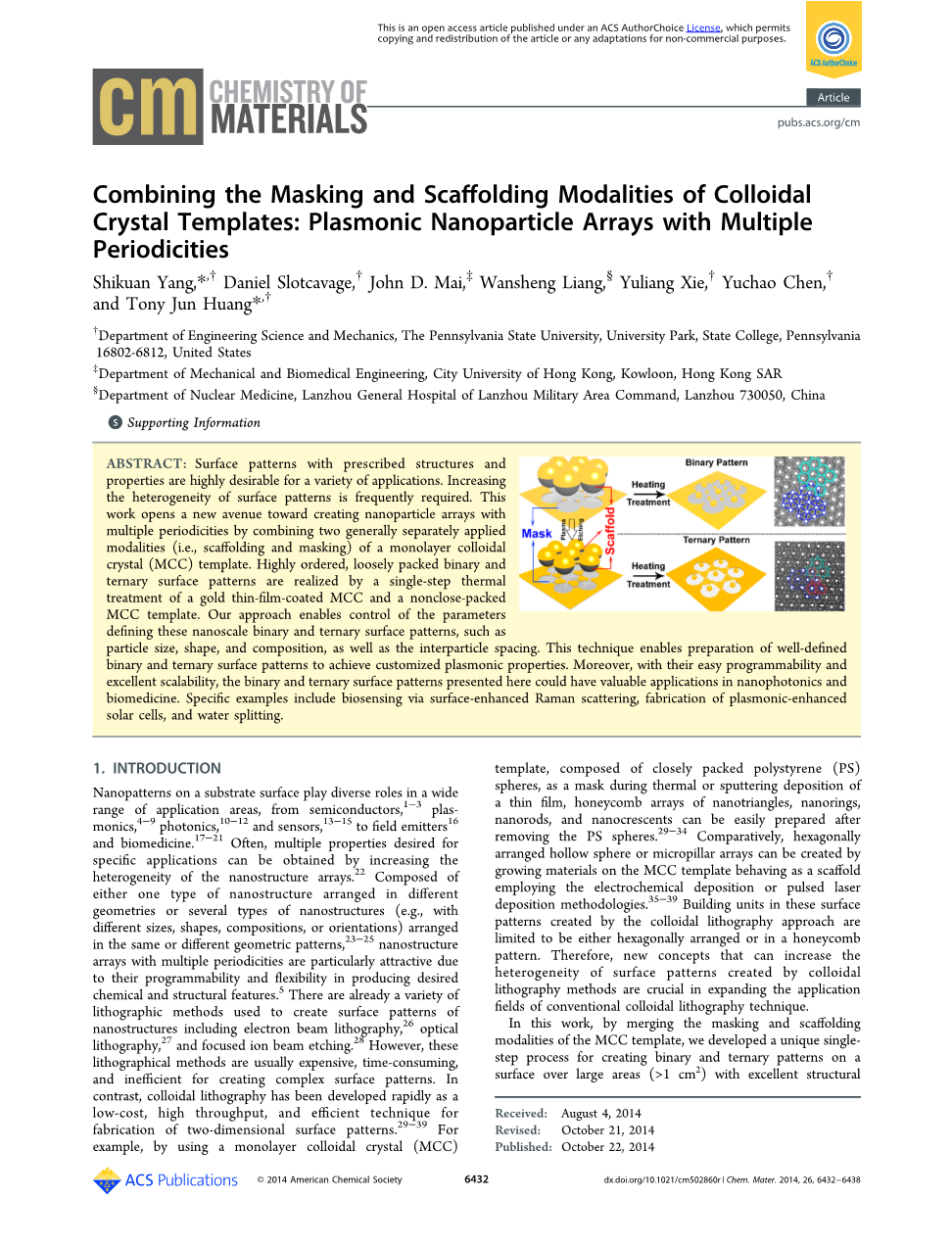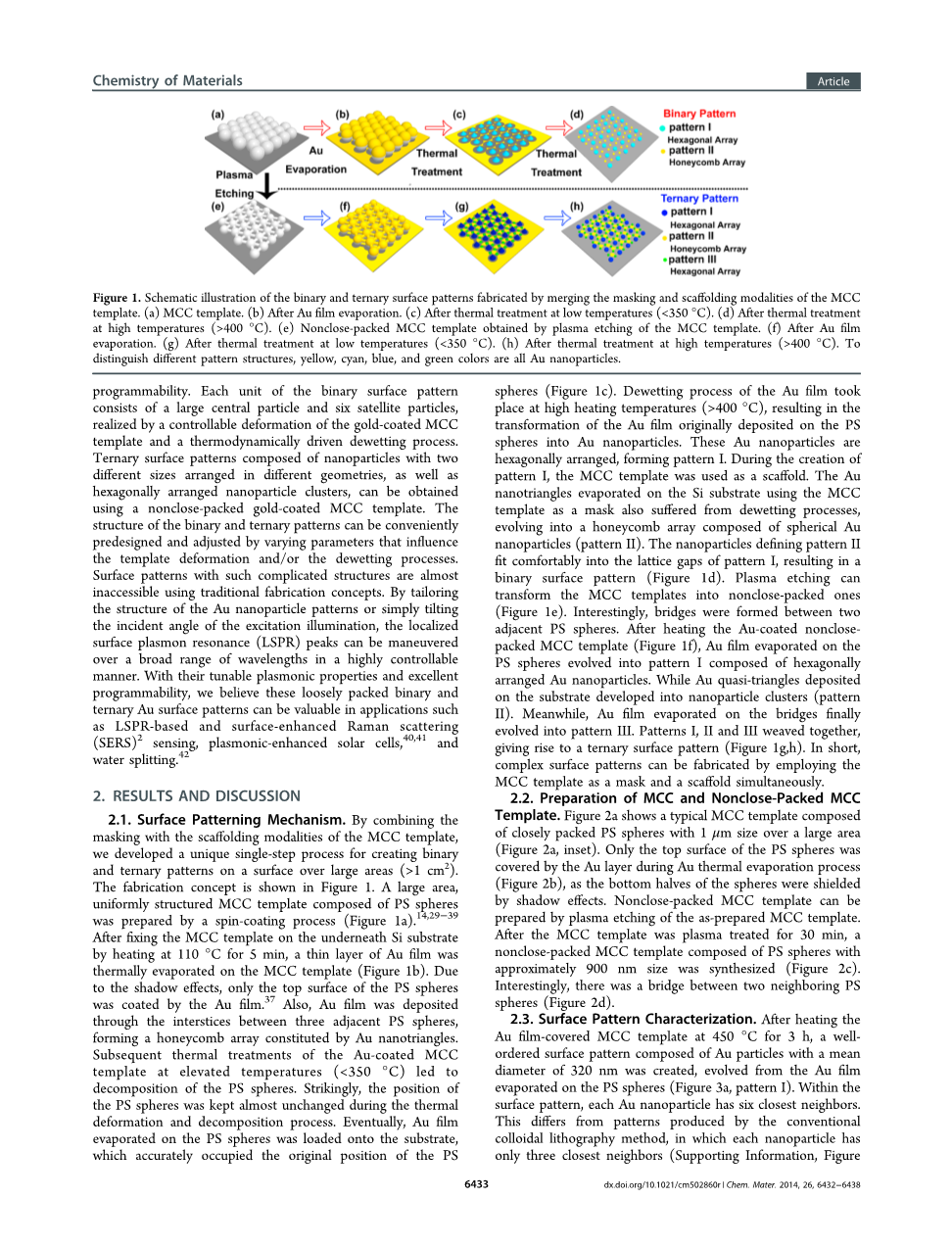本科毕业设计(论文)
外文翻译
Combining the Masking and Scaffolding Modalities of Colloidal Crystal Templates: Plasmonic Nanoparticle Arrays with Multiple Periodicities
作者:Shikuan Yang, Daniel Slotcavage, John D. Mai
国籍:China,America
出处:CHEMISTRY OF MATERIALS,2014,26:6432-6438
原文正文:
ABSTRACT: Surface patterns with prescribed structures and properties are highly desirable for a variety of applications. Increasing the heterogeneity of surface patterns is frequently required. This work opens a new avenue toward creating nanoparticle arrays with multiple periodicities by combining two generally separately applied modalities (i.e., scaffolding and masking) of a monolayer colloidal crystal (MCC) template. Highly ordered, loosely packed binary and ternary surface patterns are realized by a single-step thermal treatment of a gold thin-film-coated MCC and a nonclose-packed MCC template. Our approach enables control of the parameters defining these nanoscale binary and ternary surface patterns, such as particle size, shape, and composition, as well as the interparticle spacing. This technique enables preparation of well-defined binary and ternary surface patterns to achieve customized plasmonic properties. Moreover, with their easy programmability and excellent scalability, the binary and ternary surface patterns presented here could have valuable applications in nanophotonics and biomedicine. Specific examples include biosensing via surface-enhanced Raman scattering, fabrication of plasmonic-enhanced solar cells, and water splitting.
1. INTRODUCTION
Nanopatterns on a substrate surface play diverse roles in a wide range of application areas, from semiconductors, plas- monics, photonics, and sensors, to field emitters16 and biomedicine. Often, multiple properties desired for specific applications can be obtained by increasing the heterogeneity of the nanostructure arrays. Composed of either one type of nanostructure arranged in different geometries or several types of nanostructures (e.g., with different sizes, shapes, compositions, or orientations) arranged in the same or different geometric patterns, nanostructure arrays with multiple periodicities are particularly attractive due to their programmability and flexibility in producing desired chemical and structural.There are already a variety of lithographic methods used to create surface patterns of nanostructures including electron beam lithography, optical lithography, and focused ion beam etching.However, these lithographical methods are usually expensive, time-consuming, and inefficient for creating complex surface patterns. In contrast, colloidal lithography has been developed rapidly as a low-cost, high throughput, and efficient technique for fabrication of two-dimensional surface patterns.For example, by using a monolayer colloidal crystal (MCC) template, composed of closely packed polystyrene (PS) spheres, as a mask during thermal or sputtering deposition of a thin film, honeycomb arrays of nanotriangles, nanorings, nanorods, and nanocrescents can be easily prepared after removing the PS spheres. Comparatively, hexagonally arranged hollow sphere or micropillar arrays can be created by growing materials on the MCC template behaving as a scaffold employing the electrochemical deposition or pulsed laser deposition methodologies.Building units in these surface patterns created by the colloidal lithography approach are limited to be either hexagonally arranged or in a honeycomb pattern. Therefore, new concepts that can increase the heterogeneity of surface patterns created by colloidal lithography methods are crucial in expanding the application fields of conventional colloidal lithography technique.
In this work, by merging the masking and scaffolding modalities of the MCC template, we developed a unique single- step process for creating binary and ternary patterns on a surface over large areas (gt;1 cm2) with excellent structural programmability. Each unit of the binary surface pattern consists of a large central particle and six satellite particles, realized by a controllable deformation of the gold-coated MCC template and a thermodynamically driven dewetting process. Ternary surface patterns composed of nanoparticles with two different sizes arranged in different geometries, as well as hexagonally arranged nanoparticle clusters, can be obtained using a nonclose-packed gold-coated MCC template. The structure of the binary and ternary patterns can be conveniently predesigned and adjusted by varying parameters that influence the template deformation and/or the dewetting processes. Surface patterns with such complicated structures are almost inaccessible using traditional fabrication concepts. By tailoring the structure of the Au nanoparticle patterns or simply tilting the incident angle of the excitation illumination, the localized surface plasmon resonance (LSPR) peaks can be maneuvered over a broad range of wavelengths in a highly controllable manner. With their tunable plasmonic properties and excellent programmability, we believe these loosely packed binary and ternary Au surface patterns can be valuable in applications such as LSPR-based and surface-enhanced Raman scattering (SERS) sensing, plasmonic-enhanced solar cells,and water splitting.
2. RESULTS AND DISCUSSION
2.1. Surface Patterning Mechanism.
By combining the masking with the scaffolding modalities of the MCC template, we developed a unique single-step process for creating binary and ternary patterns on a surface over large areas (gt;1 cm2). The fabr
剩余内容已隐藏,支付完成后下载完整资料


英语原文共 7 页,剩余内容已隐藏,支付完成后下载完整资料
资料编号:[278962],资料为PDF文档或Word文档,PDF文档可免费转换为Word
以上是毕业论文外文翻译,课题毕业论文、任务书、文献综述、开题报告、程序设计、图纸设计等资料可联系客服协助查找。


